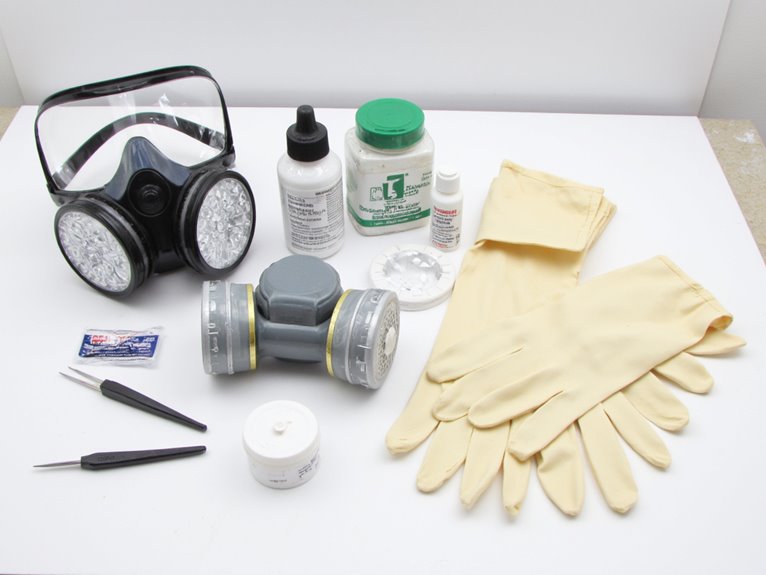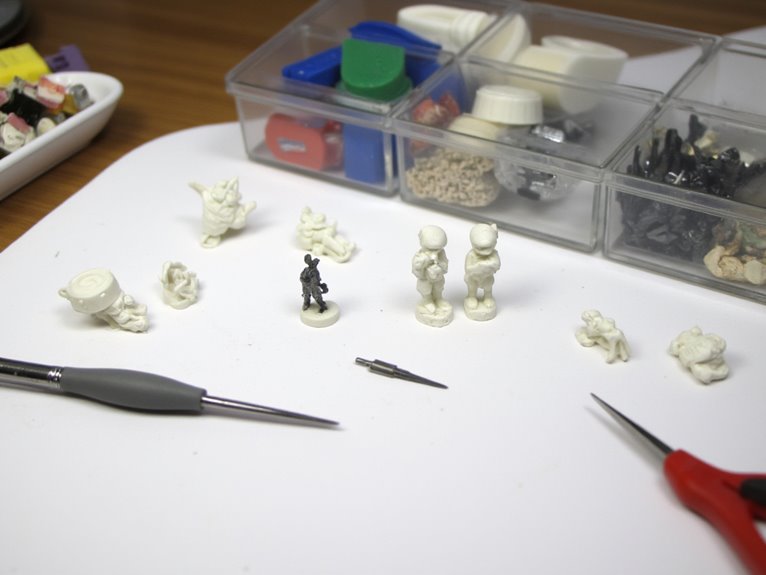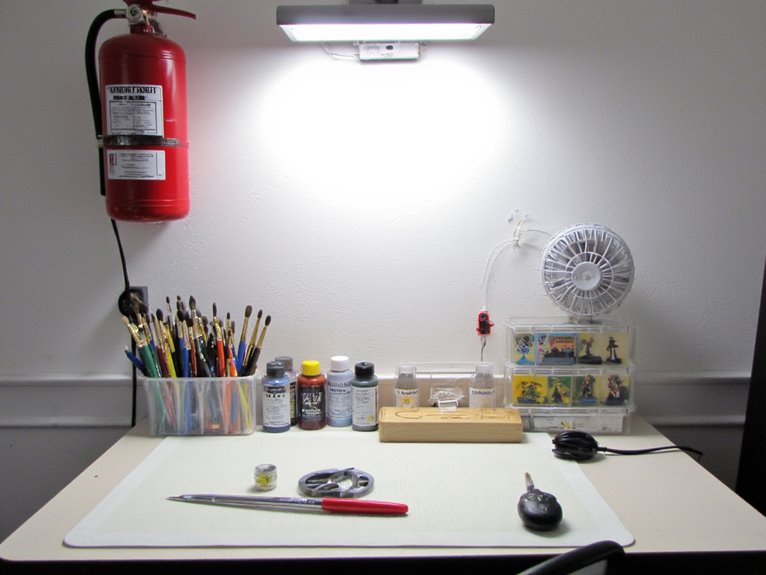We are supported by our audience. When you purchase through links on our site, we may earn an affiliate commission, at no extra cost for you. Learn more. Last update on 30th June 2025 / Images from Amazon Product Advertising API.
You’ll need proper ventilation replacing studio air 10 times per hour, NIOSH-approved respirators with P95/P100 filtration, and double nitrile gloves when handling solvents with flashpoints as low as 95°F. Install local exhaust ventilation to capture toxic vapors at their source, maintain three-foot clearances from heat sources, and store flammable materials in fireproof cabinets. Use safety goggles during resin preparation, dispose of solvent-soaked rags in metal containers, and keep fire extinguishers within fifteen feet of work zones for thorough protection against chemical and fire hazards.
Notable Insights
- Ensure proper ventilation with air replacement 10 times per hour and use local exhaust systems to capture solvent vapors at source.
- Wear double nitrile gloves, NIOSH-approved respirators, and safety glasses when handling solvents, pigments, and resin materials.
- Store flammable materials in fireproof cabinets, position work stations three feet from heat sources, and install fire extinguishers nearby.
- Keep Safety Data Sheets updated for all chemicals and use low-VOC alternatives whenever possible to minimize health risks.
- Dispose of solvent-soaked rags in metal containers and maintain sealed chemical containers when not in use to prevent accidents.
Chemical Safety and Material Handling
While miniature painting may seem like a harmless hobby, the materials you’ll handle contain chemicals that pose serious health and safety risks if misused.
Chemical safety begins with understanding your materials. Solvents like turpentine have flashpoints of 95°F, creating fire hazards. Pigments can release toxic dust when handled improperly.
Knowledge of your painting materials is the foundation of safe practice—understanding chemical properties prevents accidents before they happen.
Material handling requires specific protective equipment. Wear double nitrile gloves when cleaning brushes with solvents. Use NIOSH-approved respirators with toxic dust filters for powder pigments. Safety glasses protect against splashes during mixing. When using airbrush equipment, maintain proper ventilation and operate within the recommended 20-35 PSI range to ensure safe atomization.
Store flammable solvents in approved safety cans. Keep chemical oxidizers segregated from other materials. Never eat, drink, or smoke while painting to prevent accidental ingestion. Accidental ingestion through hand-to-mouth contact poses significant risks when working with pigmented materials.
Maintain updated Safety Data Sheets for all chemicals in your workspace.
Ventilation Requirements and Air Quality Control
Your miniature painting workspace requires proper ventilation to protect you from harmful chemical vapors and maintain safe air quality levels.
Effective ventilation systems combine strategic airflow management, targeted solvent vapor removal, and temperature control to create an environment where you can work safely for extended periods. Stale air presence and lingering chemical odors indicate that your current ventilation setup may be inadequate for safe painting sessions.
Setting up the right combination of natural and mechanical ventilation will prevent the accumulation of volatile organic compounds while maintaining comfortable working conditions. Proper ventilation systems should replace studio air 10 times per hour to ensure adequate safety when working with solvents and other painting materials.
Workspace Ventilation Setup
Proper ventilation serves as your primary defense against hazardous fumes from paints, solvents, and primers that can compromise both your health and work quality. Cross-ventilation through opposite-wall windows creates natural airflow that removes contaminants effectively. Position roof vents at high points to expel hot air while installing ground-level louvers for cool air intake.
| Component | Natural Method | Mechanical Enhancement |
|---|---|---|
| Air Intake | Windows, ground vents | 6-inch HVAC ductwork |
| Air Exhaust | Roof vents, doors | Window exhaust fans |
| Airflow Control | Strategic positioning | Continuous duct fans |
Mechanical systems boost ventilation efficiency beyond natural methods. Install exhaust fans in windows to actively pull contaminated air outside—never into adjacent rooms. Size components appropriately for your workspace dimensions and maintain equipment regularly for best performance. Adequate airflow also accelerates paint drying while preventing common finish defects like blistering or uneven curing. Avoid using fans to simply blow air around without a clean air source, as this inadequate approach actually increases your exposure to hazardous materials.
Solvent Vapor Control
Solvent vapors present the most serious airborne hazard in miniature painting workshops, requiring specialized control measures beyond standard room ventilation.
OSHA’s 300 ppm permissible exposure limit doesn’t guarantee safety in small studios. You can’t rely on odor detection—harmful concentrations often build up before you notice them.
Implement local exhaust ventilation for effective vapor extraction. Position a box fan in one window to pull contaminated air outside while maintaining fresh air intake through another opening. This creates cross-ventilation that captures fumes at their source.
Keep solvent containers sealed when not in use to minimize vapor release.
Maintain solvent awareness by limiting opened containers and using low-VOC alternatives when possible.
Install air purifiers with activated carbon filters for additional protection. Choose quality solvents over low-cost options that often contain harmful additives which can increase your exposure risks. Regular equipment maintenance ensures continuous effectiveness of your vapor control system.
Temperature and Airflow
Effective vapor control relies on proper airflow patterns and temperature management throughout your workspace. You’ll need balanced air circulation to prevent hot, contaminated air from accumulating near your ceiling. Position intake vents low and exhaust outlets high to capitalize on natural convection currents.
This creates steady airflow that removes solvent vapors before they concentrate.
Temperature regulation affects ventilation effectiveness considerably. Warm air rises and carries fumes upward, so you must make sure upper exhaust vents can handle increased thermal loads.
Install appropriately sized fans—typically 6-inch duct fans work well for small workshops. Cross-ventilation through opposite wall openings enhances air circulation patterns. Consider installing a large skylight if natural lighting is limited, as it can also serve as an additional heat exhaust point when properly positioned.
Keep workspace temperatures moderate to prevent excessive vapor generation while maintaining comfortable working conditions that don’t compromise your ventilation system’s performance.
Essential Protective Equipment for Workshop Safety

When working with miniature paints, solvents, and adhesives, you’ll need specific protective gear to safeguard against chemical exposure and physical hazards. Proper safety protocols require respiratory protection, hand barriers, and eye shielding to prevent health risks.
| Protection Type | Equipment | Key Features |
|---|---|---|
| Respiratory | Organic vapor mask | P95/P100 filtration rating |
| Hand | Nitrile gloves | Chemical-resistant, cut-proof materials |
| Eye | Safety goggles | Impact-resistant, secure fit |
| Body | Long-sleeve coveralls | Chemical penetration resistance |
| Hearing | Earplugs/earmuffs | NRR-rated for compressor noise |
Replace respirator filters regularly to maintain effectiveness. Inspect gloves before each use for tears or contamination. Choose eyewear with proper impact ratings and clean lenses frequently. Wear protective clothing made from abrasion-resistant materials. Keep hair restrained and remove loose jewelry that could catch on equipment. For hobbyists working with chemical fumes and fine particulates, half face respirators with food-grade silicone construction provide comfortable protection during extended painting sessions.
Safe Preparation and Handling of Miniature Components

You’ll encounter two primary hazards when preparing miniature components: resin materials that require careful handling and sharp metal edges that can cause injury.
Resin components often contain uncured chemicals and fine particulates that become airborne during sanding, so you must work in well-ventilated areas and wear appropriate respiratory protection.
Sharp edges on metal miniatures demand immediate attention since these can slice through skin easily, requiring you to file or sand problem areas before handling the components extensively.
When cleaning resin prints, always use non-toxic formulations to minimize health risks and reduce harmful fume exposure in your workspace.
Resin Component Preparation
Before beginning any miniature painting project, proper preparation of resin components forms the foundation for achieving professional results and maintaining your health throughout the process.
Start with thorough part inspection to identify manufacturing defects like warping or excess flash. Check for resin curing issues that affect paint adhesion. Document any damaged pieces immediately.
Remove glossy release agents by washing components in lukewarm water with dishwashing liquid. Soak parts for five minutes, then scrub gently with a soft-bristled brush. Rinse thoroughly and air dry completely.
Always wear nitrile gloves and dust masks when handling resin. Use safety goggles during filing operations. Work in well-ventilated areas to minimize exposure to airborne particles and maintain proper workspace safety protocols.
Sharp Edge Management
After completing the cleaning and drying process, you’ll encounter another significant safety concern that requires immediate attention. Sharp edges and burrs on resin miniatures pose serious injury risks during handling and assembly.
Begin with thorough edge identification, examining each component under adequate lighting to spot razor-sharp flash, pointed details, and rough casting marks. Small parts present choking hazards for children under 14, making careful inspection mandatory.
For effective burr removal, use fine-grit sandpaper or miniature files, working in single directions to prevent new sharp points. Wear cut-resistant nitrile gloves and safety glasses during preparation.
Handle delicate pieces with tweezers rather than bare fingers. File aggressively only when necessary to preserve miniature details. Keep your workspace organized and tools properly maintained for ideal safety and control during edge management procedures.
Workshop Hygiene and Best Practices
While maintaining a clean, organized workspace might seem secondary to achieving stunning paint effects, proper hygiene practices form the foundation of successful miniature painting and protect your health during extended hobby sessions.
Implement proper brush maintenance by rinsing with cold water only—warm water damages bristles permanently. Tap brushes gently against glass or porcelain containers to preserve shape. After cleaning, reshape bristles to maintain points.
Establish surface protection using self-healing cutting mats, coasters, or newspapers. This prevents staining and simplifies cleanup. Keep paper towels accessible for immediate spill management and brush wiping during drybrushing techniques.
Organize paints and tools in designated holders to minimize contamination risks. Clean spills immediately to prevent dried paint buildup.
Never eat or drink near painting materials—this reduces ingestion hazards and cross-contamination considerably.
For deep cleaning between painting sessions, consider using non-toxic formulas specifically designed for brush maintenance, as these safely remove stubborn residues while conditioning bristles for extended tool life.
Fire Prevention and Workspace Organization

Although miniature painting involves relatively small amounts of materials, fire hazards can escalate rapidly in poorly organized workshops where flammable paints, thinners, and solvents accumulate near heat sources.
Your workspace layout directly impacts fire risk levels throughout the painting area. Position painting stations at least three feet from heating lamps and electrical equipment. Store all flammable materials in fireproof cabinets when not in use. Install fire extinguishers within fifteen feet of each work zone.
Maintain clear evacuation routes by keeping aisles unobstructed and marking exits with reflective tape. Designate specific zones for mixing, painting, and storage activities. This prevents cross-contamination and reduces accident probability.
Clean up spills immediately and dispose of solvent-soaked rags in metal containers with tight-fitting lids to prevent spontaneous combustion. When working with epoxy putties for miniature modifications, ensure adequate ventilation as the chemical curing process can generate heat and fumes that pose additional safety risks.
On a final note
You’ve now acquired the essential knowledge to maintain a safe miniature painting environment. Proper ventilation systems, chemical storage protocols, and protective equipment aren’t optional—they’re mandatory for your health. Don’t compromise on air quality monitoring or fire prevention measures. Your workshop’s safety depends on consistent application of these guidelines. Remember that accidents occur when you skip procedures or rush through safety checks. Stay vigilant and maintain these standards consistently.
